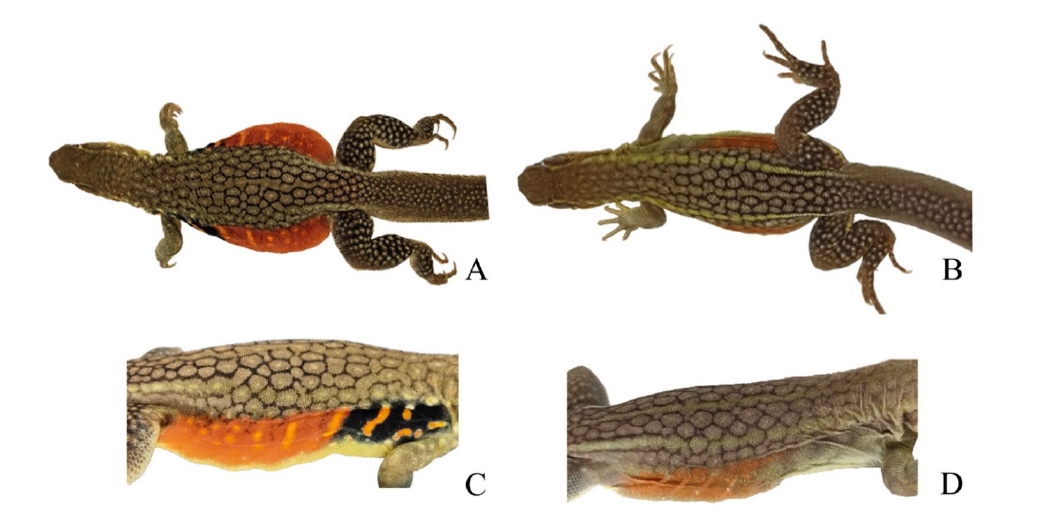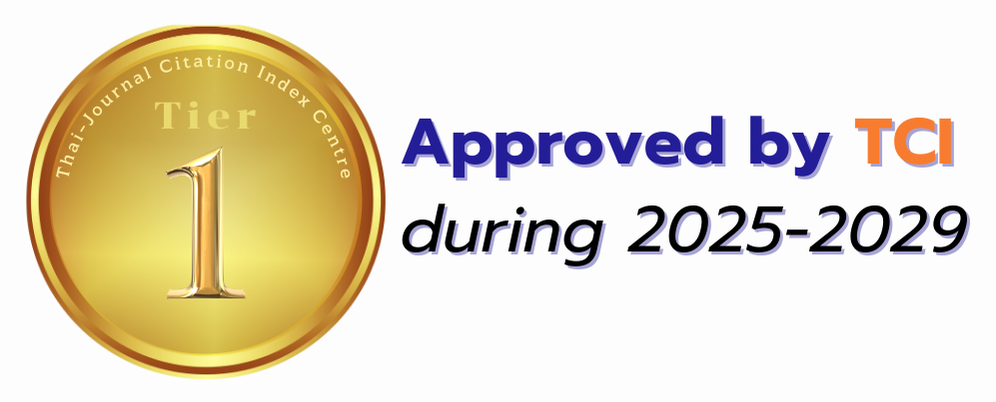Protein Content and Composition in Leiolepis rubritaeniata from Northeastern Thailand
DOI:
https://doi.org/10.34044/tferj.2025.9.2.6372Keywords:
Amino acids, Butterfly lizard, Crude protein, Leiolepis rubritaeniata, ND2 geneAbstract
Background and Objectives: The genus Leiolepis (family Agamidae), commonly known as butterfly lizards, is widely distributed across Southeast Asia and typically inhabits dry, open areas with sandy soils and sparse vegetation. Among the ten recognized species, L. rubritaeniata is notable for its distinctive red-striped flanks and occurrence in northeastern Thailand. Although previous studies have explored its taxonomy, distribution, and behavior, limited information is available on its physiological and nutritional biology, particularly regarding protein content and amino acid composition. Proteins are essential macromolecules involved in tissue development, immune response, metabolism, and energy balance, and reptiles living in seasonal environments may develop adaptations to cope with fluctuating food availability. In some rural communities, agamid lizards are also consumed as supplementary sources of protein, making their nutritional value relevant from both ecological and ethnobiological perspectives. Despite this importance, most reptilian nutrition studies have focused on snakes and turtles, leaving small lizard species such as L. rubritaeniata understudied. This research aims to confirm the species identity of L. rubritaeniata specimens collected from Udon Thani Province using morphological and ND2 gene sequence analyses and to determine and compare the total protein content and amino acid composition in the body and tail tissues of male and female individuals. The findings will provide baseline data that support further studies in reptilian nutritional ecology, physiological adaptation, and conservation planning.
Methodology: Specimens of L. rubritaeniata were collected from Kham Khok Sung and Bayao Subdistricts in Wang Sam Mo District, Udon Thani Province, using snares and excavation methods. Following euthanasia, liver tissues were preserved in 95% ethanol at –20 °C for DNA analysis. For protein and amino acid composition analysis, muscle samples were collected separately from two regions: (1) the body, comprising the head, neck, trunk and limbs, and (2) the tail, consisting exclusively of tail muscle. All samples were promptly processed for analysis. All specimens were deposited in the Khon Kaen Vertebrate Collection (KKUC), and the study received ethical approval from the Institutional Animal Care and Use Committee of Khon Kaen University (Ref. no. 660201.2.11/318 [50]). Species identification was based on morphology and mitochondrial ND2 gene sequences, amplified using METF6 and CO1R1 primers and sequenced by Pacific Science. Sequences were aligned in SeaView and phylogenetic trees constructed using Maximum Parsimony in PAUP* and Bayesian Inference in MrBayes, with model selection via MrModelTest. Pairwise sequence divergences were calculated in MEGA X. Morphological identification included snout-vent length (SVL), tail length, scale and pore counts, and coloration traits. Crude protein was analyzed in triplicate using the Kjeldahl method with a Gerhardt KT 8s system, and protein content was calculated from nitrogen percentage following Horwitz and Latimer’s formula. For amino acid composition, hydrolyzed samples were analyzed using ion-exchange chromatography and an automatic amino acid analyzer (SCION Artemis 6000), with detection via post-column derivatization and ninhydrin reaction.
Main Results: Molecular analyses based on the mitochondrial ND2 gene confirmed that the Leiolepis specimens from Udon Thani Province belong to L. rubritaeniata. Phylogenetic analyses using Maximum Parsimony and Bayesian Inference revealed that the new sequences (PV746783 and PV746784) clustered strongly with published L. rubritaeniata sequences in GenBank, supported by minimal genetic distances and clear separation from L. reevesii and L. glaurung. Morphologically, the Udon Thani Province specimens closely resembled L. rubritaeniata in key traits such as size, scalation, and coloration patterns, including diagnostic flank markings. Although slightly larger, their body measurements, labial counts, and femoral pore numbers fell within the species' intraspecific variation. Crude protein analysis showed significantly higher protein content in the tail than in the body in both sexes, confirmed by paired t-tests (p < 0.05), while no significant sex-based differences were observed. Amino acid profiles showed that female tail tissue contained the highest total amino acid content, with glutamic acid, aspartic acid, and lysine being the most abundant. Cysteine was consistently the least abundant across all samples. These molecular, morphological, and nutritional findings provide robust evidence for the identification of the specimens as L. rubritaeniata and highlight notable tissue-specific differences in protein quantity and amino acid composition, with possible biological and ecological significance.
Conclusion: This study confirms the identification of L. rubritaeniata specimens from Udon Thani Province, northeastern Thailand, through both molecular and morphological analyses. Mitochondrial ND2 gene sequencing placed the specimens firmly within the L. rubritaeniata clade with strong nodal support, and their external morphological traits were consistent with those of known L. rubritaeniata populations. Crude protein analysis revealed that tail tissues contained significantly higher protein levels than body tissues in both sexes, while no significant differences were found between males and females for either body or tail protein content. Amino acid profiling showed that glutamic acid, aspartic acid, and lysine were the most abundant amino acids across all samples, with the highest total amino acid content observed in female tail tissues. These findings provide evidence for the taxonomic status of L. rubritaeniata in Udon Thani and also offer new insights into its nutritional composition, particularly the higher protein and amino acid content in tail tissues, which may have implications for both biological understanding and potential utilization in reptiles and amphibians.
Downloads
References
Aust, P. W., N. V. Tri, D. J. D. Natusch & G. J. Alexander. 2017. Asian snake farms: Conservation curse or sustainable enterprise? Oryx 51: 498-05. https://doi:10.1017/S003060531600034X DOI: https://doi.org/10.1017/S003060531600034X
Beach, E. F., B. Munks & A. Robinson. 1943. The amino acid composition of animal tissue protein. Journal of Biological Chemistry. 148: 431-439. https://doi:10.1016/S0021-9258(18)72300-4 DOI: https://doi.org/10.1016/S0021-9258(18)72300-4
Boyd, C. E. & C. P. Goodyear. 1971. The protein content of some common reptiles and amphibians. Herpetologica 27: 317-320.
Caldironi, H. A. & M. E. Manes. 2006. Proximate composition, fatty acids and cholesterol content of meat cuts from tegu lizard Tupinambis merianae. Journal of Food Composition and Analysis. 19: 711-714. https://doi:10.1016/j.jfca.2005.09.005 DOI: https://doi.org/10.1016/j.jfca.2005.09.005
Černíková, M., R. Gál, Z. Polášek, M. Janíček, V. Pachlová & F. Buňka. 2015. Comparison of the nutrient composition, biogenic amines and selected functional parameters of meat from different parts of Nile crocodile (Crocodylus niloticus). Journal of Food Composition and Analysis. 43: 82-87. https//doi:10.1016/j.jfca.2015.05.001 DOI: https://doi.org/10.1016/j.jfca.2015.05.001
Chuaynkern, Y. & C. Chuaynkern. 2012. Checklist of reptiles in Thailand. Journal of Wildlife in Thailand 19: 75-162.
Cota, M., T. Neang, S. Phimmachak, N. S. Nguyen & T. Q. Nguyen. 2018. Leiolepis rubritaeniata. The IUCN Red List of Threatened Species. Available source: https://www.iucnredlist.org/. (Accessed: 3 August 2025)
Dai, Z., Z. Wu, S. Jia & G. Wu. 2014. Analysis of amino acid composition in proteins of animal tissues and foods as pre-column o-phthaldialdehyde derivatives by HPLC with fluorescence detection. Journal of Chromatography B 964: 116-127. https://doi:10.1016/j.jchromb.2014.03.025 DOI: https://doi.org/10.1016/j.jchromb.2014.03.025
Dolly, D. A. & L. Tardieu. 2023. Carcass characteristics and nutritional profile of wild Caiman crocodilus (Spectacled Caiman) meat. Emerging Animal Species 9: 100032. https://doi:10.1016/j.eas.2023.100032 DOI: https://doi.org/10.1016/j.eas.2023.100032
Essary, E. O. & R. J. Ritchey. 1968. Amino acid composition of meat removed from boned turkey carcasses by use of commercial boning machine. Poultry Science 47: 1953-1955. https://doi:10.3382/ps.0471953 DOI: https://doi.org/10.3382/ps.0471953
Gratwicke, B., M. J. Evan, P. T. Jenkins, M. D. Kusrini, R.D. Moore, J. Sevin & D.E. Wildt. 2010. Is the international frog legs trade a potential vector for deadly amphibian pathogens? Frontiers in Ecology and the Environment 8: 438-442. https://doi:10.1890/090111 DOI: https://doi.org/10.1890/090111
Grismer, J. L. & L. Grismer. 2010. Who’s your mommy? Identifying maternal ancestors of asexual species of Leiolepis Cuvier, 1829 and the description of a new endemic species of asexual Leiolepis Cuvier, 1829 from southern Vietnam. Zootaxa 2433: 47-61. https://doi:10.5281/zenodo.194748 DOI: https://doi.org/10.11646/zootaxa.2433.1.3
Hartmann, T., S. Sothanin, M. Handschuh & W. Böhme. 2012. The taxonomic status of the red-banded butterfly lizard, Leiolepis rubritaeniata Mertens, 1961, with distributional and natural history notes. Russian Journal of Herpetology 19: 108-114. https://doi:10.30906/1026-2296-2012-19-2-108-114
Hoffman, L. C. & D. M. Cawthorn. 2012. What is the role and contribution of meat from wildlife in providing high quality protein for consumption? Animal Frontiers 2: 40-53. https://doi:10.2527/af.2012-0061 DOI: https://doi.org/10.2527/af.2012-0061
Horwitz, W. & G. W. Latimer. 2000. Official Methods of Analysis of AOAC International, 17th Ed. AOAC International. Gaithersburg.
Huang, Y., X. Guo, S. Y. Ho, H. Shi, J. Li, J. Li, B. Cai & Y. Wang. 2013. Diversification and demography of the oriental garden lizard (Calotes versicolor) on Hainan Island and the adjacent mainland. PLoS One 8: 1-13. https://doi:10.1371/journal.pone.0064754 DOI: https://doi.org/10.1371/journal.pone.0064754
John, E. N. & K. R. Jones. 2024. Nutritional value of meat from selected neotropical reptiles. Emerging Animal Species 10: 100046. https://doi:10.1016/j.eas.2024.100046 DOI: https://doi.org/10.1016/j.eas.2024.100046
Klemens, M. W. & J. B. Thorbjarnarson. 1995. Reptiles as a food resource. Biodiversity & Conservation 4: 281-298. https://doi:10.1007/BF00055974 DOI: https://doi.org/10.1007/BF00055974
Köhler, G. & P. Thammachoti. 2023. A glimpse into the natural history of Leiolepis rubritaeniata Mertens, 1961 (Squamata: Leiolepididae). Asian Herpetological Research 14: 147-155. https://doi:10.1093/9780197610145.001.0001 DOI: https://doi.org/10.3724/ahr.2095-0357.2022.0037
Kumar, S., G. Stecher, M. Li, C. Knyaz & K. Tamura. 2018. MEGA X: Molecular evolutionary genetics analysis across computing platforms. Molecular Biology and Evolution 35: 1547-1549. https://doi:10.1093/molbev/msy096 DOI: https://doi.org/10.1093/molbev/msy096
Kusrini, M. D. & R. A. Alford. 2006. Indonesia’s exports of frogs’ legs. Traffic Bulletin 21: 13-24.
Macey, J. R., A. Larson, N. B. Ananjeva, Z. Fang & T. J. Papenfuss. 1997. Two novel gene orders and the role of light-strand replication in rearrangement of the vertebrate mitochondrial genome. Molecular Biology and Evolution 14: 91-104. https://doi:10.1093/oxfordjournals.molbev.a025706 DOI: https://doi.org/10.1093/oxfordjournals.molbev.a025706
Manapim, P. 2006. Studies Comparison for Protein in Asian Forest Scorpion by Kjeldahl and Biuret Methods. Ubon Ratchathani University. Ubon Ratchathani, Thailand.
Maynard, L. A. & J. K. Loosli. 1962. Animal Nutrition. 5th ed. McGraw-Hill Book Co., Inc. New York, USA.
Melville, J., M. L. Haines, J. Hale, S. Chapple & E. G. Ritchie. 2016. Concordance in phylogeography and ecological niche modelling identify dispersal corridors for reptiles in arid Australia. Journal of Biogeography 43: 1844-1855. https://doi:10.1111/jbi.12739 DOI: https://doi.org/10.1111/jbi.12739
Mertens, R. 1961. Die rassen der schmetterlingsagame, Leiolepis belliana. Senckenb Biologica 42: 507-510.
Nabhitabhata, J., T. Chan-ard & Y.Chuaynkern. 2004. Checklist of Amphibians and Reptiles in Thailand. Office of Environmental Policy and Planning. Bangkok, Thailand.
Nylander, J. A. A. 2004. MrModeltest Version 2. Program Distributed by the Author. Uppsala University. Uppsala, Sweden.
Office of Natural Resources and Environmental Policy and Planning. 2017. Thailand Red Data: Vertebrates. Ministry of Natural Resources and Environment, Bangkok, Thailand.
Phan, X. T. T., B. V. Ngo, H. D. Nguyen, Q. T. Hoang, C. D. Ngo, C. T. Bui, T. Nguyen & N. T. Hoang. 2022. Evaluating and reconstructing the genetic diversity of butterfly lizards of the genus Leiolepis Cuvier, 1829 (Reptilia: Squamata: Agamidae) in Central Vietnam. Russian Journal of Herpetology 29: 284-297. https://doi:10.30906/1026-2296-2022-29-5-284-297 DOI: https://doi.org/10.30906/1026-2296-2022-29-5-284-297
Poyarkov, N. A., T. V. Nguyen & E. S. Popov. 2023. Recent progress in taxonomic studies, biogeographic analysis, and revised checklist of reptiles in Indochina. Russian Journal of Herpetology 30: 255-476. https://doi:10.30906/1026-2296-2023-30-5-255-476 DOI: https://doi.org/10.30906/1026-2296-2023-30-5-255-476
Promnun, P., J. Khudamrongsawat, J. L. Grismer, N. Tandavanitj, C. Kongrit & P. Tajakan. 2021. Revised distribution and a first record of Leiolepis peguensis Peters, 1971 (Squamata: Leiolepidae) from Thailand. Herpetology Notes 14: 893-897.
Ronquist, F., M. Teslenko, P. Van Der Mark, D. L. Ayres, A. Darling, S. Höhna, B. Larget, L. Liu, M. A. Suchard & J. P. Huelsebeck. 2012. MrBayes 3.2: Efficient Bayesian phylogenetic inference and model choice across a large model space. Systematic Biology 61: 539-542. https://doi:10.1093/sysbio/sys029 DOI: https://doi.org/10.1093/sysbio/sys029
Sáez-Plaza, P., M. J. Navas, S. Wybraniec, T. Michałowski & A. G. Asuero. 2013. An overview of the Kjeldahl method of nitrogen determination. Part II. Sample preparation, working scale, instrumental finish, and quality control. Critical Reviews in Analytical Chemistry 43: 224-272. https://doi:10.1080/10408347.2012.751787 DOI: https://doi.org/10.1080/10408347.2012.751787
Santos, J. P. V., J. Vicente, J. Carvalho, J. Queirós, M. Vilamuelas, E. Albanell, P. Acevedo, C. Gortázar, J. Ramón López-Olvera & C. Fonseca. 2018. Determining changes in the nutritional condition of red deer in Mediterranean ecosystems: Effects of environmental, management and demographic factors. Ecological Indicators 87: 261-271. https://doi:10.1016/j.ecolind.2017.12.039 DOI: https://doi.org/10.1016/j.ecolind.2017.12.039
Swofford, D.L. 2002. PAUP*: Phylogenetic Analysis Using Parsimony (*and Other Methods), Version 4.0b10. Sinauer Associates. Massachusetts, USA.
Udomsil, N., S. Imsoonthornruksa, C. Gosalawit & M. Ketudat-Cairns. 2019. Nutritional values and functional properties of house cricket (Acheta domesticus) and field cricket (Gryllus bimaculatus). Food Science and Technology Research 25: 597-605. https://doi:10.3136/fstr.25.597 DOI: https://doi.org/10.3136/fstr.25.597
Uetz, P., P. Freed, R. Aguilar, F. Reyes & J. Hošek. 2025. The Reptile Database. Available source: http://www.reptile-database.org/. (Accessed: 25 June 2025)
van Wijngaarden, J. P., J. Wojzischke, C. van den Berg, A. Cetinyurek-Yavuz, R. Diekmann, Y. C. Luiking & J. M. Bauer. 2020. Effects of nutritional interventions on nutritional and functional outcomes in geriatric rehabilitation patients: a systematic review and meta-analysis. Journal of the American Medical Directors Association 21: 1207-1215. https://doi:10.1016/j.jamda.2020.04.012 DOI: https://doi.org/10.1016/j.jamda.2020.04.012
Wanchai, P., A. Rujirawan, M. L. Murdoch, A. Aksornneam, P. Promnun, A. Kaatz, J. J. Gregory, E. Nguyen, W. van Iderstein, E. S. H. Quah, L. L. Grismer, J. L. Grismer & A. Aowphol. 2024. The description of the first rock dwelling species of butterfly lizard Leiolepis Cuvier, 1829 (Squamata, Agamidae) from the Khorat Plateau in northeastern Thailand. ZooKeys 1210: 299-324. https://doi:10.3897/zookeys.1210.127557 DOI: https://doi.org/10.3897/zookeys.1210.127557
Wild Animal Conservation and Protection Act. 2019. Wild Animal Conservation and Protected Act, B.E. 2562 (2019). FAO, Rome.
Yu, T. Y., J. D. Morton, S. Clerens & J. M. Dyer. 2017. Cooking‐induced protein modifications in meat. Comprehensive Reviews in Food Science and Food Safety 16: 141-159. https://doi:10.1111/1541-4337.12243 DOI: https://doi.org/10.1111/1541-4337.12243
Zhang, Q., Y. Hou, F. W. Bazer, W. He, E. A. Posey & G. Wu. 2021. Amino acids in swine nutrition and production. In: Wu, G. (ed.). Amino Acids in Nutrition and Health. Advances in Experimental Medicine and Biology. Springer. Cham, Switzerland. DOI: https://doi.org/10.1007/978-3-030-54462-1_6







.png)





